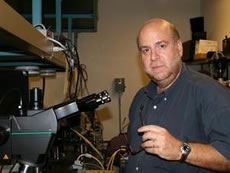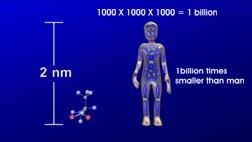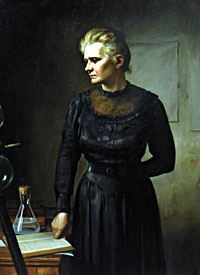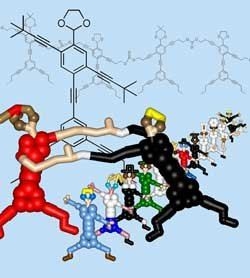 |
| Sadik Esener in his lab |
Think Big, Create Small
“Remote controlling small objects inside the body excites me the most!” says Sadik Esener from his campus office at the University of California, San Diego (UCSD). As professor of electrical and computer engineering at the renowned Jacobs School of Engineering and the principal investigator of the Center for Cancer Nanotechnology Excellence, Esener is tackling big problems in powerfully tiny ways. If you’ve ever played music on an iPod, you already are familiar with nanotechnology, a developing field of science in which technology on the molecular and atomic level creates astonishing new miniaturized products.
Esener is working with an interdisciplinary team on devices that seek out and destroy tumors. Their research and discoveries will have profound implications in the field of medicine. Their devices will deliver promising new anti-cancer treatments to targeted locations in the body. The goal is to create mother ships that home in on tumors and release what are called “nanoparticle payloads.” Mother ships would identify and take images of tumors, take measurements, and then blast the tumors by releasing anti-cancer drugs on cue.
As a scientist, Esener is thrilled about “being able to engineer an object so small and explore inside the human body.” If this sounds like the storyline of a Hollywood movie or the stuff of science fiction, it indeed once was. In 1966, a sci-fi movie was released that had a big impact on Esener’s life. “When I was 10 years old, I saw the movie, Fantastic Voyage, and I loved it.” The movie follows a group of scientists who enter a submarine. They’re miniaturized, injected into someone’s body and have only one hour to repair a blood clot in a guy’s brain. “You know, when I was asked to lead this center, I watched the movie again that night.” A mere forty years after the release of this work of fiction, thanks to technology, miniaturization is no longer fantasy and a little boy’s fascination is becoming reality.
As if developing such splendid microscopic mechanisms and blowing away bad-guy tumors isn’t beneficial enough, nanotechnology will enhance medical treatment in other major ways. In addition to better targeting drugs, creating smaller novel mechanisms will help doctors monitor and get rapid non-invasive feedback on treatment effectiveness as well as require smaller tissue samples for biopsies. The benefits to patients are no surgery or cuts, less side effects, the need for reduced drug quantities and the possibility of non-compatible drugs working together.
 |
| From The NanoKids ™ educational outreach program |
How small is small?
Researchers work at the micro- and nano-scale level. The prefix “nano” means one-billionth so a nanometer is one billionth of one meter. To give you an idea about how small these sizes really are, red blood cells are a big 2.5 micrometers long whereas our DNA--or genetic material--is in the 2.5 nanometer range. A human hair is about 80,000 nanometers wide and a sheet of paper is about 100,000 nanometers thick. "The Scale of Things" from the Office of Basic Energy Sciences, Office of Science, U.S. Department of Energy illustrates the oh-so-small sizes of natural and manmade things.
Students can also visualize our world at the level of atoms and molecules by visiting a website developed by "The NanoKids™", an educational outreach program headed by Dr. James M. Tour, Chao Professor of Chemistry and Director of the Carbon Nanotechnology Laboratory at Rice University. Dr. Tour and his team turned molecular structures into cartoon figures called NanoKids, or NanoPutians, and created an animated science video to teach kids about going nano!
 |
| Madame Curie |
Science in his blood
Esener’s scientific curiosity might be in his blood. His grandfather worked with the renowned Madam Curie and his mother used to tell him, “I hope you discover the things that your grandfather didn’t.” As a kid, he loved building with Legos and also taking everything apart. “I destroyed one of my grandma’s watches,” he admitted. “I controlled it with a magnet and totally broke what was inside the watch.” He laughs mischievously and says, “I still love opening watches and looking at them!”
Of Turkish origin, Esener grew up in France, earned his B.S. in Istanbul, and his M.S. from the University of Michigan in electrical engineering. For his masters, he fabricated integrated circuits. Esener considered becoming a medical doctor and registered for medical school in Strasbourg, but he lasted one week. In 1983, he arrived in San Diego and went on to earn his Ph.D. in Applied Physics and Electrical Engineering from UCSD. A professor he knew suggested it was a good thing to look into optics and he did. He is now an internationally known expert in photonics and opto-electronics and has been involved with five startup companies based on technology developed in his laboratories.
To create these tiny, intricate nano-structures and their innovative applications, a team from various disciplines must work together. Collaborating with physicists, biologists, chemists and materials experts, an engineer such as Esener plays a key role. Engineers build nanodevices. At UCSD, Esener’s expertise will be crucial in yet another way. He will help locate the motherships, or carriers,in the body optically using fluorescence and ultrasound. It’s important that the motherships dock where there’s cancer, at just the right place, to deliver minute amounts of cancer-fighting medicine only where it’s needed.
Inspired by Heroes
Passionate about his work, Esener is also respectful of those who came before him. When asked about his heroes, Esener did not hesitate. “I liked Edison because he’s very practical. Almost all good things we use in the 20th and 21st century are related to electronics and he had an impact on that," Esener declares. His second hero is a popular one. " Einstein was a total theoretician, yet he was still able to unravel the secrets of physics.”
Nanoscale Materials Today
We are already using nanoscale materials in a range of products including computer hard drives and the latest display technology for laptops, cell phones and digital cameras. Nanoscale materials are also used in automotive sensors, landmine detectors, paints, sunscreens and cosmetics, tennis racquets, eyeglass coatings and wound dressings. Products and therapeutics in the biological field are as yet fairly undeveloped.
In 2005, as part of a five-year, $20 million dollar initiative, the National Cancer Institute (NCI) established seven Centers for Nanotechnology Excellence in the US. Researchers will work to fight cancer with nanoscale devices that find and destroy tumor cells without harming healthy tissue. Esener and his peers at the UCSD center seek to develop anti-cancer therapies that directly target tumor cells as well as more accurate and faster diagnostics.
 |
| Each NanoPutian cartoon figure is based on a molecule |
Why Kids Should Pursue Careers in Science, Engineering and Technology
“If you remove pain and illness, quality of life improves,” Esener relates, so working in the field of nanomedicine specifically, or science, engineering and technology in general, can improve people’s quality of life. Transferring nanotechnology techniques from industry to biology has become one of today’s most fascinating scientific areas of discovery. Esener reminds us that the impact diseases such as cancer have on society are not limited to families and victims. He says, “Cancer costs $190 billion to the US economy.” He joked that “money could be better spent building toys.”
Future applications in nanotechnology, be they in medicine or industry, are mind-boggling. Advanced drug delivery systems could include implantable devices that administer and monitor drugs. Glass coatings could turn the sun’s energy into electricity. Wear-resistant coatings could extend the lifetime of moving parts in cars and machinery.
Experts estimate that within 2-5 years, cooling chips will replace compressors in cars, refrigerators and air conditioners, sensors will detect airborne toxins, and we’ll have the means to provide inexpensive, clean energy. Even smaller computers will store more information and process data even faster. Imagine nanorobots capable of building nanomachines. The benefits of nanotechnology lie around the corner and will touch all of our lives.
Page created on 8/17/2014 10:26:11 AM
Last edited 8/17/2014 10:26:11 AM
